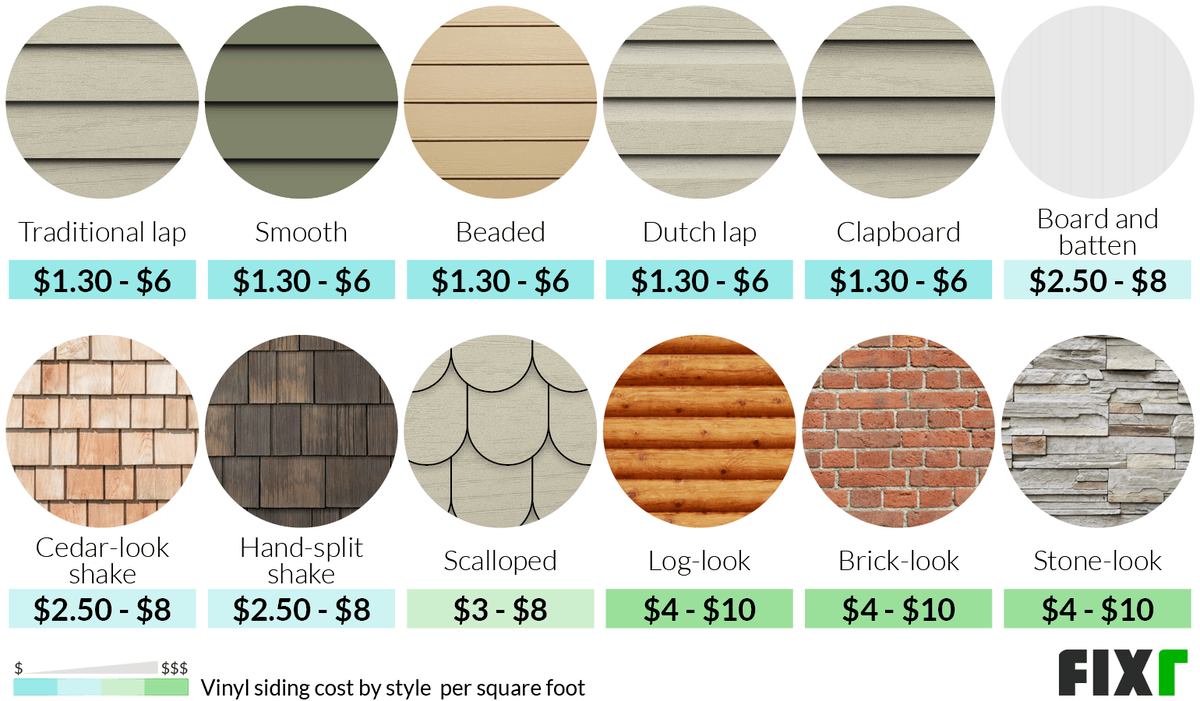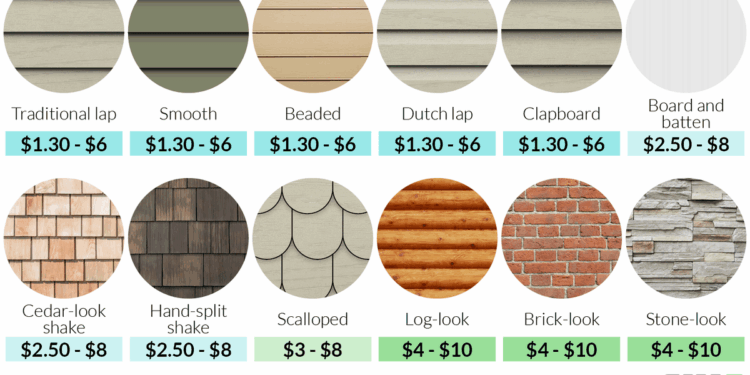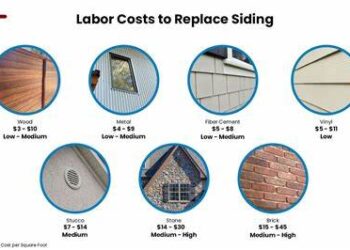Exploring the cost of putting vinyl siding on your house, this introduction sets the stage for a detailed discussion on the various aspects involved. From factors influencing the cost to practical cost-saving tips, this guide covers it all in a comprehensive yet engaging manner.
Diving deeper into the breakdown of average costs and the benefits of choosing vinyl siding, this overview aims to provide valuable insights for homeowners considering this renovation project.

Factors influencing the cost of putting vinyl siding on a house
When considering the cost of putting vinyl siding on a house, several factors come into play that can significantly impact the overall expense. Understanding these factors can help homeowners make informed decisions about their siding project.
Quality of Vinyl Siding
The quality of the vinyl siding material used can greatly affect the cost of the project. Higher quality materials tend to be more durable and have better warranties, but they also come with a higher price tag. For example, premium vinyl siding with advanced features like insulation or enhanced durability will cost more than basic vinyl siding options.
Size of the House
The size of the house is a crucial factor in determining the cost of putting vinyl siding. Larger homes require more materials and labor to complete the installation, leading to higher costs. For instance, a small ranch-style home will generally cost less to side with vinyl compared to a large two-story house with multiple levels and complex architectural features.
Removal of Existing Siding
If there is existing siding on the house that needs to be removed before installing vinyl siding, this can add to the overall cost. The labor and time involved in removing old siding can vary depending on the type of material and condition of the existing siding.
For example, removing old wood siding may be more labor-intensive and costly compared to removing aluminum siding.
Installation Complexity
The complexity of the installation process can impact the cost of putting vinyl siding on a house. Factors such as the presence of architectural details, window trims, or uneven surfaces can make the installation more challenging and time-consuming, leading to higher labor costs.
For instance, a house with intricate architectural features will require more precision and skill during installation, resulting in a higher overall cost.
Average cost breakdown of vinyl siding installation
When it comes to putting vinyl siding on a house, understanding the average cost breakdown can help homeowners budget effectively for this home improvement project. Let's delve into the various costs involved in the installation process.
Cost of Materials vs. Labor
One of the key components of the cost breakdown for vinyl siding installation is the division between materials and labor expenses. On average, materials account for approximately 30% to 50% of the total cost, while labor costs make up the remaining 50% to 70%.
It's important to consider both aspects when planning your budget for this project.
Additional Costs During Installation
Aside from materials and labor, homeowners may also incur additional costs during the vinyl siding installation process. These extra expenses could include the removal of old siding, necessary repairs to the house's exterior, insulation installation, trim work, and any unforeseen structural issues that may arise.
It's essential to factor in these potential costs to avoid any budget surprises.
Cost-saving tips for installing vinyl siding
Installing vinyl siding can be a cost-effective way to improve the appearance and value of your home. Here are some tips to help you save money on your vinyl siding installation:
Shop around for affordable materials
Consider visiting local home improvement stores or searching online for deals on vinyl siding materials. Look for sales, discounts, or clearance items to help lower the overall cost of your project.
Consider DIY installation
If you have some experience with home improvement projects, you may be able to install the vinyl siding yourself. By taking on the installation as a DIY project, you can save on labor costs. However, make sure you have the necessary tools and knowledge to complete the job correctly.
Take advantage of seasonal sales
Many home improvement stores offer discounts on building materials during certain times of the year. Keep an eye out for seasonal sales or promotions on vinyl siding to help reduce your overall costs.
Reuse existing materials
If your current siding is in good condition, you may be able to reuse some of the materials when installing vinyl siding. This can help you save money on new materials and reduce waste.
Get multiple quotes from contractors
If you decide to hire a professional contractor for the installation, be sure to get quotes from multiple companies. Comparing prices and services can help you find the best deal and potentially negotiate a lower price for the project.
Maintain proper upkeep
To ensure your vinyl siding lasts for years to come, make sure to properly maintain and clean it regularly. By taking care of your siding, you can avoid costly repairs or replacements in the future.
Benefits of choosing vinyl siding for a house
Vinyl siding offers numerous advantages that make it a popular choice for homeowners looking to improve the aesthetics and durability of their homes. Not only does vinyl siding enhance the curb appeal of a house, but it also provides long-lasting protection against the elements.
Low Maintenance
Vinyl siding is virtually maintenance-free compared to other materials like wood or metal. It does not require painting or staining, saving homeowners time and money on upkeep. A simple rinse with a garden hose can keep vinyl siding looking clean and fresh.
Durability
Vinyl siding is resistant to rot, rust, and pests, making it a durable option for homes in various climates. It can withstand harsh weather conditions, such as heavy rain, snow, and wind, without deteriorating or losing its color.
Cost-Effectiveness
While the initial cost of installing vinyl siding may be higher than some other materials, the long-term savings can justify the investment. With its low maintenance requirements and durability, homeowners can save on repair and replacement costs over time.
Energy Efficiency
Vinyl siding can improve the energy efficiency of a home by providing an extra layer of insulation. This can help reduce heating and cooling costs throughout the year, making it a more environmentally friendly option for homeowners.
Variety of Styles and Colors
Vinyl siding comes in a wide range of styles and colors, allowing homeowners to choose a design that complements their home's architecture and personal taste. Whether looking for a traditional look or a modern aesthetic, there is a vinyl siding option to suit every preference.
Eco-Friendly
Vinyl siding is a sustainable option as it can be recycled at the end of its lifespan. This makes it an eco-friendly choice for homeowners looking to reduce their environmental impact while still enjoying the benefits of durable and attractive siding.
Closing Notes
Concluding our exploration of the cost to put vinyl siding on a house, this summary encapsulates the key points discussed while leaving readers with a sense of clarity and understanding. Whether you're looking to cut costs or make a long-term investment, vinyl siding offers a range of benefits worth considering.
Helpful Answers
What factors can influence the cost of putting vinyl siding on a house?
Factors like material quality, labor costs, house size, and additional features can impact the overall cost.
How do DIY options help in saving costs for vinyl siding installation?
DIY projects can save money by eliminating labor costs, but homeowners should have the necessary skills and tools for a successful installation.
What are the long-term savings associated with choosing vinyl siding over other materials?
Vinyl siding requires minimal maintenance and lasts for many years, offering cost savings in terms of repairs and replacements over time.















